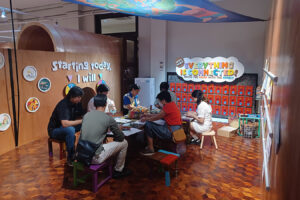FOR THE PAST 20 years, the Center for Art, New Ventures and Sustainable Development (CANVAS) has been promoting literacy and exploring national identity among children through art exhibits and children’s books, commissioning various acclaimed Filipino artists and writers.
Elias and His Trees, CANVAS’ first book, written by Augie Rivera and illustrated by Romeo Forbes, was published in 2005. To date, the organization has published over 50 books covering a variety of themes — children’s rights, the environment, democracy, friendship, family, and grief.
Starting June 14, CANVAS is holding the benefit art exhibit CANVAS: 20 Years of Art and Stories for its 20th anniversary. It is currently open to the public on the fourth floor of the National Museum for Fine Arts in Manila. The exhibit will run for a year.
“We cling to the hope and possibility that somewhere down the line, one of the books that we publish, one of the artworks that we show, or one of ideas that we share, will trigger the imagination of one child who will then be moved to change the world for the better,” said CANVAS Founder and Executive Director Gigo Alampay at the exhibit preview in May.
Some notable titles include the award-winning Hanapin Ang Sagot: Ano Ang Batas Militar?, Karapat Dapat, and I Like Wearing Rainbows. Other books, such as Nadia and the Blue Stars and Silim, Prinsesa ng Dilim, have been adapted into stage plays and musicals.
CANVAS has worked with prominent figures in Philippine literature to author and translate books, including Vim Nadera, Cyan Abad-Jugo, and Butch Dalisay. Talents in the visual arts who have shared their gifts with CANVAS include National Artist Benedicto “BenCab” Cabrera, Daniel dela Cruz, Renato Barja, Jonathan Madeja, Mark Justiniani, Joy Mallari, Leeroy New, Elmer Borlongan, Lito Mondejar, Renz Baluyot, Liza Flores, and Ang Ilustrador ng Kabataan (Ang INK), to name a few.
THE EXHIBITCANVAS: 20 Years of Art and Stories is a colorful yet compact summary of the art and literature representing the various advocacies it has promoted in the past. The climate change section in the exhibit has interactive elements, including a drawing table and a matching game to foster appreciation for nature. The “safe space” area teaches about internet safety, while the “karapat dapat” section talks about children’s rights in a corner filled with pillows and mats.
At the heart of the exhibition hall is “Read. Imagine. Create.” where visitors can read, play, and rest. There will be workshops and activities on storytelling, poetry writing, story writing, illustration and art appreciation, and upcycling scheduled throughout the year.
For parents and educators, there will be talks on topics such as explaining Martial Law to children and ensuring internet safety for the family. The complete schedule and registration details will be posted on CANVAS’ social media accounts.
“The show includes several interactive elements designed to engage young visitors. Some sections feature archways that children can go through, inviting them to explore at their own pace,” said CANVAS curator and visual artist Jaime Pacena II.
As for the selection of artworks and books on display, Mr. Alampay explained that the exhibit aims to show “a collective portrait of the values, stories, and creative energies that have shaped CANVAS over the past 20 years.”
Aside from the paintings-turned-storybooks that have been commissioned by the non-profit in the past, long-time collaborators like Daniel dela Cruz and Renato Borja, Jr. created large-scale sculptures just for the exhibit.
“To complete this experience, we partnered with Arkisens, a collective of artist-architects, whose contribution helped translate the curatorial vision into a tangible, spatial encounter,” said Mr. Alampay.
MUSEUM, BOOK PROGRAMSMr. Pacena added that the exhibit, with its rounded wooden corners and exploratory maze-like structure, hopes to serve as a blueprint for the soon-to-open Tumba-Tumba Children’s Museum of Philippine Art in Ibaan, Batangas, where everything on display at the National Museum, plus those still to come, will find a permanent home.
Situated on a 15,000-square-meter piece of land, Tumba-Tumba is currently open only for special events or by appointment.
At the moment, there are five installations at the Tumba-Tumba museum: Elmer Borlongan and Lito Mondejar’s Tree Huggers; Leeroy New’s first permanent structure, I Am the Explorer that takes the form of a spaceship; Don Bryan Bunag’s Lilim; Cian Dayrit’s The Anti-Monument (The Weight of Words); and John Santos and Pam Yan Santos’ Not A Mirage.
The dream project of having a permanent structure to house art for children and families to visit and see is in the process of being funded through collaborations and sponsorships, according to Mr. Alampay.
In the meantime, CANVAS has its “One Million Books for One Million Filipino Children” campaign, wherein the non-profit donates its books to children in public schools and underserved communities across the Philippines. The books are also available for free download from the CANVAS website.
CANVAS: 20 Years of Art and Stories is on view at Galleries 25 and 26 on the fourth floor of the National Museum of Fine Arts until June 2026. — Brontë H. Lacsamana
